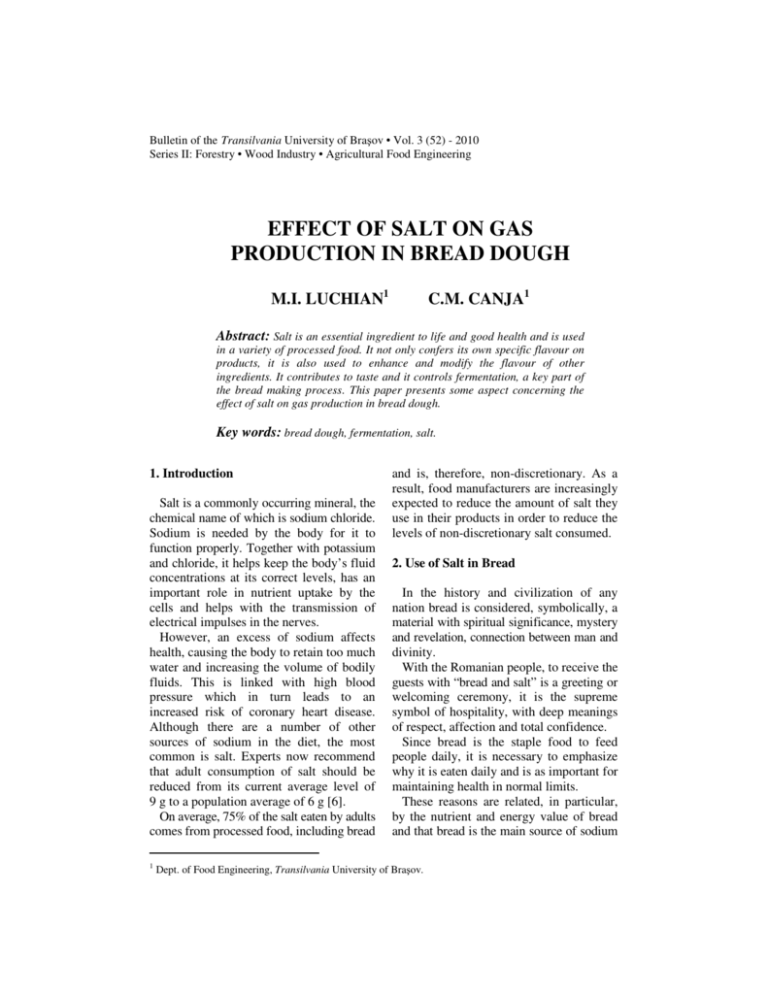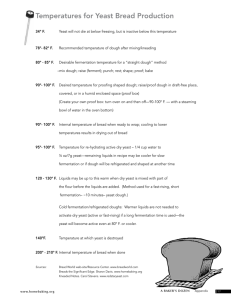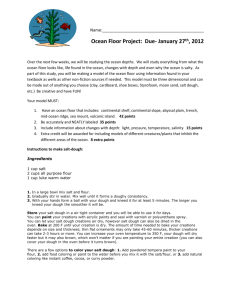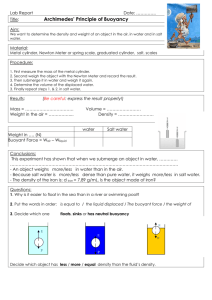Luchian, M.I., Canja, C.M.: Effect of Salt on Gas Production in Bread
advertisement

Bulletin of the Transilvania University of Braşov • Vol. 3 (52) - 2010 Series II: Forestry • Wood Industry • Agricultural Food Engineering EFFECT OF SALT ON GAS PRODUCTION IN BREAD DOUGH M.I. LUCHIAN1 C.M. CANJA1 Abstract: Salt is an essential ingredient to life and good health and is used in a variety of processed food. It not only confers its own specific flavour on products, it is also used to enhance and modify the flavour of other ingredients. It contributes to taste and it controls fermentation, a key part of the bread making process. This paper presents some aspect concerning the effect of salt on gas production in bread dough. Key words: bread dough, fermentation, salt. 1. Introduction Salt is a commonly occurring mineral, the chemical name of which is sodium chloride. Sodium is needed by the body for it to function properly. Together with potassium and chloride, it helps keep the body’s fluid concentrations at its correct levels, has an important role in nutrient uptake by the cells and helps with the transmission of electrical impulses in the nerves. However, an excess of sodium affects health, causing the body to retain too much water and increasing the volume of bodily fluids. This is linked with high blood pressure which in turn leads to an increased risk of coronary heart disease. Although there are a number of other sources of sodium in the diet, the most common is salt. Experts now recommend that adult consumption of salt should be reduced from its current average level of 9 g to a population average of 6 g [6]. On average, 75% of the salt eaten by adults comes from processed food, including bread 1 and is, therefore, non-discretionary. As a result, food manufacturers are increasingly expected to reduce the amount of salt they use in their products in order to reduce the levels of non-discretionary salt consumed. 2. Use of Salt in Bread In the history and civilization of any nation bread is considered, symbolically, a material with spiritual significance, mystery and revelation, connection between man and divinity. With the Romanian people, to receive the guests with “bread and salt” is a greeting or welcoming ceremony, it is the supreme symbol of hospitality, with deep meanings of respect, affection and total confidence. Since bread is the staple food to feed people daily, it is necessary to emphasize why it is eaten daily and is as important for maintaining health in normal limits. These reasons are related, in particular, by the nutrient and energy value of bread and that bread is the main source of sodium Dept. of Food Engineering, Transilvania University of Braşov. 168 Bulletin of the Transilvania University of Braşov • Vol. 3 (52) - 2010 • Series II for the body. Sodium intake of bread is made by using an appropriate amount of salt, amount to be closely monitored so as neither to influence consumer health, nor the quality of the bread making process. As a result, the aims of this study is to observe the influence of the amount of salt added in dough on the ability to form and to retain gases on dough fermentation. Salt often performs a technological role in food and cannot always be removed totally. Salt is a major component in bread, and performs several important functions. The reasons for using salt can be divided into three broad categories: processing reasons, sensory (taste) reasons, and preservation reasons. In some cases it performs all three of these functions, and in many situations the distinction between them is not clear. It acts as a seasoning and so flavours the dough. It acts as a colour enhancer by reducing the action of sugar within the dough. That means if there is less salt in the dough, yeast action will be more than normal and there will be less sugar for caramelization resulting in poor crust colour. On the other hand if more salt is present, there will be more sugar left at the time of baking due to the controlling effect of salt on yeast and the crust colour will be dark [2]. By slowing down the yeast action, it allows the fermentation to be controlled and retards bacteria growth. It also helps to control the texture by strengthening the gluten. Too much salt kills some of the yeast cells thus preventing the dough from rising properly and making it sticky. The tightening gives strength to the gluten, enabling the dough to efficiently hold carbon dioxide, which is released into the dough as a by-product of the yeast fermentation. When salt is left out, the resulting dough is slack and sticky in texture, work-up is difficult, and bread volume is poor. Salt has a retarding effect on the activity of the yeast. The cell wall of yeast is semipermeable, and by osmosis it absorbs oxygen and nutrients, as it gives off enzymes and other substances to the dough environment. Water is essential for these yeast activities. Salt by its nature is hygroscopic, that is, it attracts moisture. In the presence of salt, the yeast releases some of its water to the salt by osmosis, and this in turn slows the yeast’s fermentation or reproductive activities. If there is an excess of salt in bread dough, the yeast is retarded to the point that there is a marked reduction in volume. If there is no salt, the yeast will ferment too quickly [2]. Salt influences gluten behaviour, decreases yeast activity in the dough, thus retarding gas production, and enhances bread flavour [5]. Fig. 1. Influence of salt on yeast propagation Influence of salt on yeast multiplication is shown in Figure 1 [5]. Uncharged salts (such as sodium chloride) influence hydrophobic interactions as they induce conformational changes of the biopolymers in dough. It is generally agreed that salt increases dough development time, resistance to extension and extensibility. However, research on the effect of salt on breads has shown conflicting results. For instance, fundamental rheology has been recently used to describe the effect of large amounts of salt on dough with dissimilar results [1], [4]. Luchian, M.I., et al.: Effect of Salt on Gas Production in Bread Dough Furthermore, various authors have reported salt addition as increasing, decreasing or having no effect on specific volume measurements [3]. The Expert Committee on Vitamins and Minerals highlighted cereals and cereal products, in particular bread, as a major source of sodium in the diet. 95% of the sodium in bread comes from salt. 3. Materials and Method To make experimental determinations we can use an installation whose diagram is shown in Figure 2. 169 to 500 mL measuring cylinders inverted in a container of water to measure the gas production. For bread dough, there has been used 25% yeast solution and 25% salt solution. In order to check the effect of salt concentration on gas production, dough was prepared as follows with varying volumes of salt: Probe Flour [g] 25% salt solution [mL] 25% yeast solution [mL] A 250 b 250 c 250 d 250 0 15 30 50 15 15 15 15 4. Result and Discussion Amount of gas produced in four dough pieces were recorded after every 10 minutes until the rate of gas production is established. The results are presented in Table 1. Table 1 Amount of gas produced in time Time [min] Fig. 2. Schematic drawing of the setup to measure dough gas production Installation consists of the following: measuring cylinders (500 mL), mixing bowls, conical flasks, stoppers for conical flasks, rubber tubes, weighing scale. The subject of this research is the bread dough, made following the same recipe for manufacturing, but modifying the content of salt solution. Thus, four pieces of dough were formed, which were mixed in separate containers and finished kneading with fingers incorporating all losing particles. After mixing four dough pieces each one was placed in a 500 mL conical flask connected 0 10 20 30 40 50 60 70 80 90 100 Volume of gas [mL] a b c d 0 0 0 0 30 20 14 6 57 43 26 12 75 59 43 20 95 77 57 24 122 95 69 34 140 116 85 45 176 142 107 63 213 164 124 87 233 203 134 106 253 215 140 114 According to the graph gas formation has decrease with high salt concentration (Figure 3). This is because salt has a tightening effect on yeast cells which reduces the gas production. 170 Bulletin of the Transilvania University of Braşov • Vol. 3 (52) - 2010 • Series II Gas production (mL) 300 250 a 200 b 150 c 100 d 50 0 0 10 20 30 40 50 60 70 80 90 100 Time (min) Fig. 3. Effect of salt on gas production 5. Conclusions References Gas formation of the dough decreases with the increase in salt concentration. Salt has a retarding effect on the activity of the yeast. If there is an excess of salt in bread dough, the yeast is retarded to the point that there is a marked reduction in volume. If there is no salt, the yeast will ferment too quickly. In this sense, the salt aids in controlling the pace of fermentation. Salt levels will vary in baked products according to the functional needs. In general salt levels have fallen gradually in foods because of concerns over high levels of sodium in many diets. 1. Larsson, H.: Effect of pH and Sodium Chloride on Wheat Flour Dough Properties: Ultracentrifugation and Rheological Measurements. In: Cereal Chemistry 79 (2002), p. 544-545. 2. Miller, R.A., Hoseney, R.C.: Role of Salt in Baking. In: CFW 53 (2008), p. 4-6. 3. Salvador, A., Sanz, T., Fiszman, S.M.: Dynamic Rheological Characteristics of Wheat Flour-Water Doughs - Effect of Adding NaCl, Sucrose and Yeast. In: Food Hydrocolloids 20 (2005), p. 767960. 4. Wu, J., Beta, J., Clarke, H.: Effects of Salt and Alkaline Reagents on Dynamic Rheological Properties of Raw Oriental Wheat Noodles. In: Cereal Chemistry 83 (2006), p. 211-217. 5. *** ANAMOB NEWS nr. 125: Asociaţia Naţională a Industriilor de Morărit şi Panificaţie din România. p. 4-5, 2004. 6. *** COMA: Nutritional Aspects of Cardiovascular Disease Report of the Cardiovascular Review Group. Committee on Medical Aspects of Food and Nutrition HMSO London, 1994. Acknowledgements This paper is supported by the Sectoral Operational Programme Human Resources Development (SOP HRD), financed from the European Social Fund and by the Romanian Government under the contract number POSDRU: Investment in sustainable development through doctoral scholarships INDED POSDRU ID 59321.







